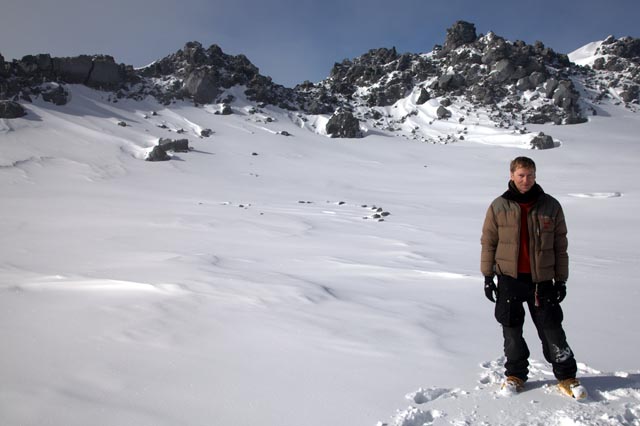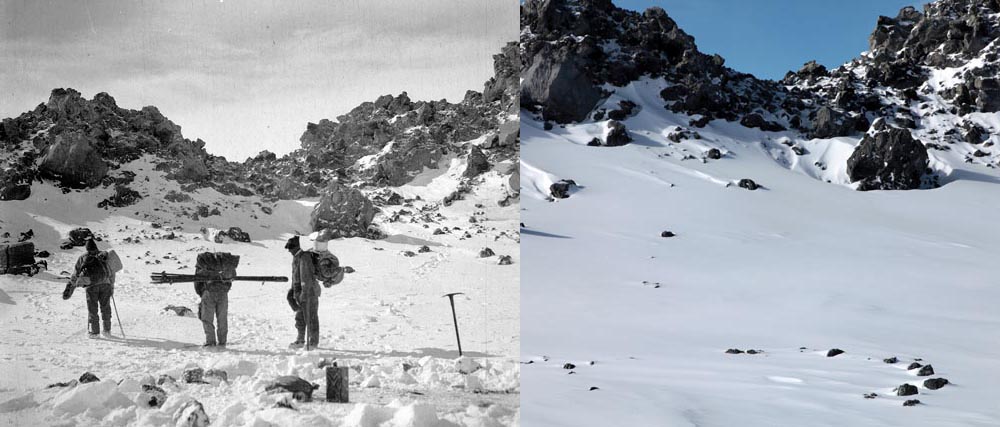|
Historic momentNew sites and monuments added to Antarctic Treaty heritage listPosted January 3, 2014
A pair of campsites located high on the flanks of an active volcano in Antarctica – once used by British explorers a little more than a century ago – officially became part of history. The 50 nations that manage most activities on the continent through the Antarctic Treaty System Last year, volcanologist Clive Oppenheimer 
Photo Courtesy: Clive Oppenheimer
Volcanologist Clive Oppenheimer stands at the site of Highest Camp, used by British explorers on Mount Erebus a century ago.
The two-week British expedition up Mount Erebus had been led by Raymond Priestley. The adventurers had set out on Dec. 4 from Cape Royds, where the famous explorer Ernest Shackleton had built an expedition base in 1908. Priestley’s notes describe at least two camps on Erebus. Oppenheimer located what has been dubbed Upper Summit Camp by matching rock formations to a photograph of one camp. A semicircle of rocks that appeared to be assembled by hand was the final piece of evidence. A volcanologist at the University of Cambridge He located a second camp, called Lower Camp E, with the same bit of photographic sleuthing, using images in the collection maintained by the Scott Polar Research Institute (SPRI) It was on the Terra Nova expedition that Scott led his famously doomed expedition to reach the geographic South Pole from his base camp at Camp Evans on Ross Island. He and his four men all perished on the return journey after losing the race to Norwegian Roald Amundsen. While history has sometimes judged Scott harshly for some of his decisions, the Briton has more recently been recognized for the ground-breaking research his team conducted. “While their simple campsites obviously lack the spectacle of a structure like the hut at Cape Evans, they nevertheless are a testament to an expedition that gathered valuable cartographic and geologic data,” Oppenheimer said. “Their pioneering work provided foundations for the research we carry out today on Erebus volcano.” Principal investigator Phil Kyle at New Mexico Tech Growing listIn 1972, the Antarctic Treaty nations established an official list of Historic Sites and Monuments 
Photo Credit: Peter Rejcek
A bronze bust of polar explorer Adm. Richard E. Byrd was erected at McMurdo Station in 1965.
There are only a few U.S. monuments, including a bronze bust of America’s most famous polar explorer – Adm. Richard E. Byrd – that was erected at McMurdo Station The only extant U.S. structures designated as an historic site are off the Antarctic Peninsula on Stonington Island. East Base was erected and used during two U.S. wintering expeditions: the Antarctic Service Expedition (1939-1941) and the Ronne Antarctic Research Expedition (1947-1948). Scott’s first expedition base, built in 1902 for the British Antarctic Expedition of 1901-04 at a site known at Hut Point, is also an historic site that was later incorporated into an Antarctic Specially Protected Area In 1964, the New Zealand Antarctic Society, with assistance from the United States, partially restored the hut. The New Zealand Antarctic Heritage Trust 
Photo Credit: Peter Rejcek
Conservation work at historic Discovery Hut began during the 2013-14 austral summer.
The two other historic designations approved at the annual Antarctic Treaty Consultative Meeting included a commemorative plaque for the first permanently occupied German Antarctic research station “Georg Forster” that opened in April 1976, and a Russian drilling complex building that was constructed in the summer season of 1983-84. The latter was used to collect ancient ice core samples at Vostok Station. No additional investigations have been conducted at the Erebus camps to locate any possible artifacts that may have been left behind by the explorers. However, the designation now preserves the sites for future study. The joint proposal from the United Kingdom, New Zealand and United States to designate the camps as historic sites notes: “The locations of the camps are of significant interest to Antarctic historians, and uncontrolled access to the sites, which might disturb any additional historic remains would be of concern.” Said Oppenheimer by e-mail, “I am glad to know these sites have been formally recognized. So much of the attention on the ‘heroic era’ has focused on the epic treks, but what Raymond Priestley's team achieved on Erebus was also pretty extraordinary.” |



For USAP Participants |
For The Public |
For Researchers and EducatorsContact UsNational Science FoundationOffice of Polar Programs Geosciences Directorate 2415 Eisenhower Avenue, Suite W7100 Alexandria, VA 22314 Sign up for the NSF Office of Polar Programs newsletter and events. Feedback Form |



